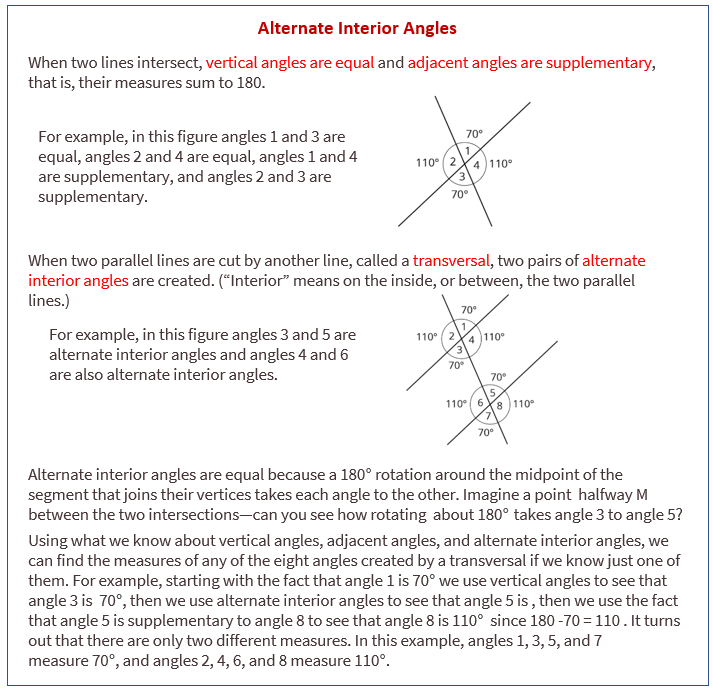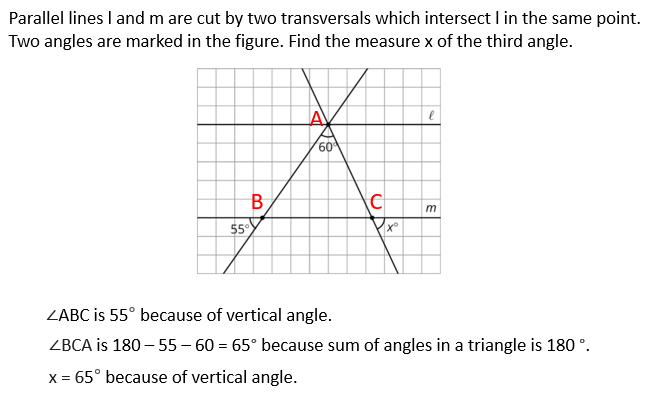Illustrative Mathematics Grade 8, Unit 1, Lesson 14: Alternate Interior Angles
Learning Targets:
- If I have two parallel lines cut by a transversal, I can identify alternate interior angles and use that to find missing angle measurements.
Related Pages
Illustrative Math
Grade 8
Lesson 14: Alternate Interior Angles
Let’s explore why some angles are always equal.
Illustrative Math Unit 8.1, Lesson 14 (printable worksheets)
Lesson 14 Summary
The following diagrams describe how to identify vertical angles and alternate interior angles.

Lesson 14.1 Angle Pairs
- Find the measure of angle JGH. Explain or show your reasoning.
- Find and label a second 30 degree angle in the diagram. Find and label an angle congruent to angle JGH.
Lesson 14.2 Cutting Parallel Lines with a Transversal
Lines AC and DF are parallel. They are cut by transversal HJ.
- With your partner, find the seven unknown angle measures in the diagram. Explain your reasoning.
- What do you notice about the angles with vertex B and the angles with vertex E?
- Using what you noticed, find the measures of the four angles at point B in the second diagram. Lines AC and DF are parallel.
- The next diagram resembles the first one, but the lines form slightly different angles. Work with your partner to find the six unknown angles with vertices at points B and E.
- What do you notice about the angles in this diagram as compared to the earlier diagram? How are the two diagrams different? How are they the same?
Are you ready for more?
Parallel lines l and m are cut by two transversals which intersect l in the same point. Two angles are marked in the figure. Find the measure x of the third angle.
Lesson 14.3 Alternate Interior Angles Are Congruent
- Lines l and k are parallel and t is a transversal. Point M is the midpoint of segment PQ.
Find a rigid transformation showing that angles MPA and MQB are congruent. - In this picture, lines l and k are no longer parallel. M is still the midpoint of segment PQ.
Lesson 14 Practice Problems
- Use the diagram to find the measures of each angle. Explain your reasoning.
- Lines k and l are parallel, and the measure of angle ABC is 19 degrees.
a. Explain why the measure of angle ECF is 19 degrees. If you get stuck, consider translating line l by moving B to C.
b. What is the measure of angle BCD? Explain. - The diagram shows three lines with some marked angle measures.
Find the missing angle measures marked with question marks. - The two figures are scaled copies of each other.
a. What are some ways that you can tell they are scaled copies?
b. What is the scale factor that takes Figure 1 to Figure 2?
c. What is the scale factor that takes Figure 2 to Figure 1?
The Open Up Resources math curriculum is free to download from the Open Up Resources website and is also available from Illustrative Mathematics.
Try out our new and fun Fraction Concoction Game.
Add and subtract fractions to make exciting fraction concoctions following a recipe. There are four levels of difficulty: Easy, medium, hard and insane. Practice the basics of fraction addition and subtraction or challenge yourself with the insane level.

We welcome your feedback, comments and questions about this site or page. Please submit your feedback or enquiries via our Feedback page.
